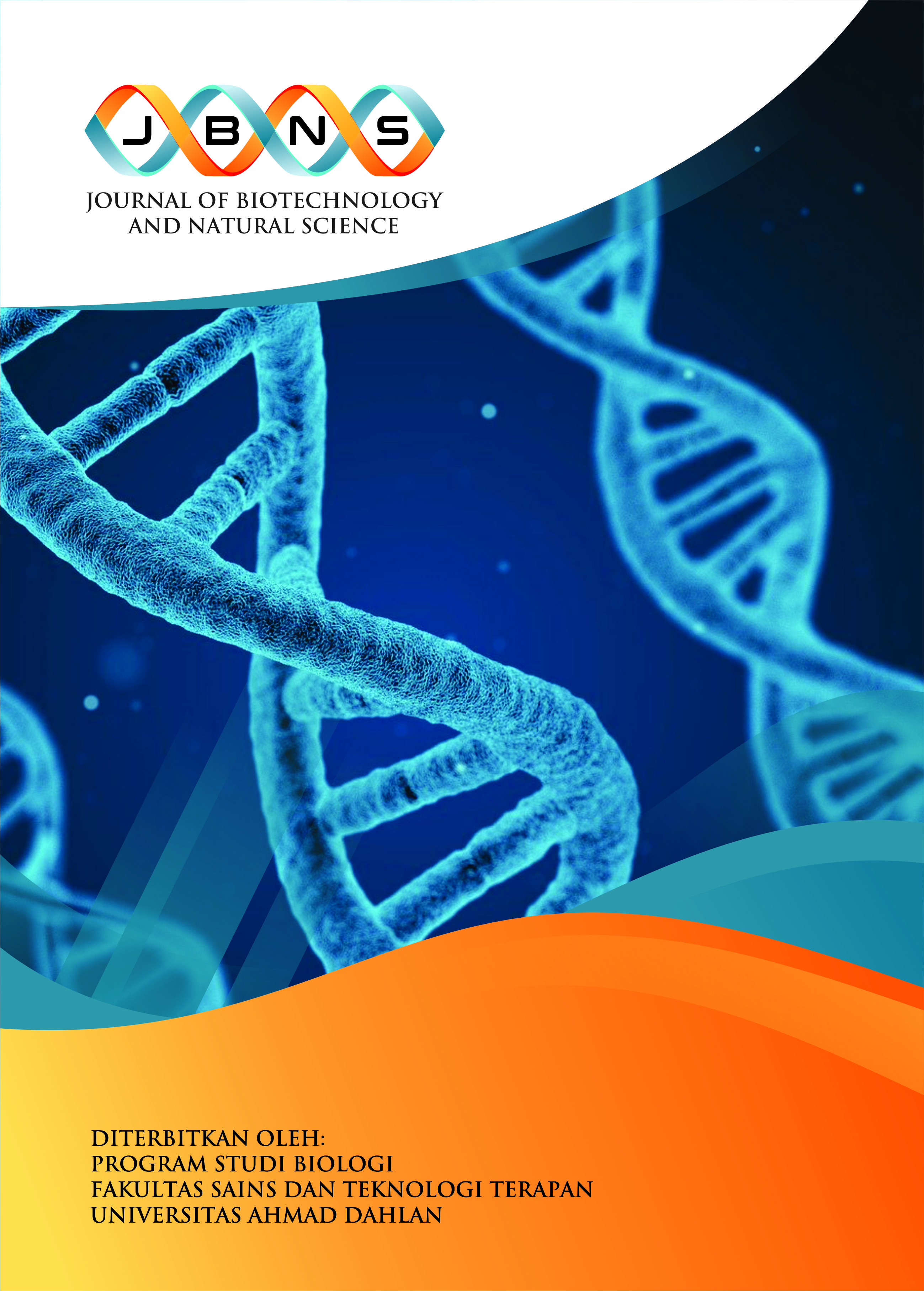Prevalence and Intensity of Anchor Worm (Lernaea cyprinacea L.) Ectoparasite in Koi Fish (Cyprinus carpio L.) at Bantul Koi Farm D.I. Yogyakarta
DOI:
https://doi.org/10.12928/jbns.v1i1.4736Keywords:
Anchor worm, BAntul Koi Farm, koi fish, Intensity, PrevalenceAbstract
One obstacle in the cultivation of Koi fish (Cyprinus carpio L.) in Bantul Koi Farm D.I. Yogyakarta is a disease caused by parasites of anchor worms (Lernaea cyprinacea L.). Therefore, this study observed the prevalence and intensity of anchor worm ectoparasites in Koi fish in Bantul Koi Farm. Taking fish samples using the purposive sampling technique. Each of three fish individuals was taken as replication from three populations, namely Showa, Shiro and Saragoi, with a size of 28-36 cm. The prevalence and intensity are determined by the observation method by counting the number of anchor worms found. Inferential statistics carried out data analysis of the number of ectoparasites in each population. The results showed that the highest anchor tick ectoparasite prevalence was found in the Shiro population (100%) and the lowest in the Saragoi population (33%). The highest intensity was in the Showa population (4 individu/ fish), and the lowest was in the Shiro population (2 individu/ fish), although all of them were in a low category. The highest number of ectoparasites was obtained from the Showa population (8 individuals) and the lowest in the Saragoi population (3 individuals), but it was not statistically significant. The high prevalence in the Shiro population is due to the high stocking density. Anchor flea ectoparasites attacked the skin and fins of Koi fish and were not found to attack gills. The conclusion of this study is the highest prevalence of anchor tick ectoparasites was found in the Shiro population (100%) and the lowest in the Saragoi population (33%). The highest intensity was found in the Showa population (4 individu/ fish) and the lowest in the Shiro population (2 individu/ fish), even though all of them were in a low category.
References
Abbas, F., Ashraf, M., Hafeez-ur-Rehman, M., Iqbal, K. J., Abbas, S, and Javid, A. (2014). Lernaea
Susceptibility, Infestation and its Treatment in Indigenous Major and Exotic Chinese Carps
Under Polyculture System. Pakistan J. Zool, XLVI(5), 1215-1222.
Azmi, H., Indriyanti, D.R., Karianda N. Identifikasi Ektoparasit Pada Ikan Koi (Cyprinus Carpio L)
di Pasar Ikan Hias Jurnatan Semarang. Unnes J Life Sci, II(2), 64-70.
Firdausi, A.P., Rahman. (2019). Metazoa Ektoparasitik Pada Ikan Koi Cyprinus carpio di Daerah
Sukabumi. Prosiding Seminar Nasional Teknologi Terapan Inovasi dan Rekayasa (SNT2IR).
pp.149-155. Program Pendidikan Vokasi Universitas Halu Oleo, Sulawesi Tenggara,
Indonesia.
Hasan, Usman M., Sadapotto, A., Elihami. (2020) Cara Memelihara, Mencegah, dan Mengatasi
Penyakit pada Ikan Koi. Maspul Journal of Community Empowerment , II(2), 64-71.
Hardiko, Y. J., Hidayat, N., Cholissodina, I. (2018). Diagnosis Penyakit Ikan Koi Menggunakan
Metode Naive Bayes Classifier. Jurnal Pengembangan Teknologi Informasi dan Ilmu
Komputer, II(11), 5310-5316.
Hossain, Md. Mer. M., Ferdoushi, J., and Rupon, A. H. (2018). Biology of Anchor Worms (Lernaea
cyprinacea). Journal of Entomology and Zoology Studies, VI(1), 910-917
Kilawati, Y., Maimunah, Y., Muttaqin, A., Kartikasari, D. P., Bhawiyuga, A., Amrillah, A. (2020).
Implementasi Internet Of Aquaculture (IoA) untuk Deteksi Kualitas Lingkungan Secara
Cepat dalam Upaya Pemberdayaan Kelompok Pembudidaya Ikan Koi Di Blitar. Journal Of
Innovation And Applied Technology, VI(2), 1104-1110.
Maulana, D. M., Muchlisin, Z. A., Sugito, S. (2017). Intensitas dan Prevalensi Parasit Pada Ikan
Betok (Anabas testudineus) dari Perairan Umum Daratan Aceh Bagian Utara. Jurnal Ilmiah
Mahasiswa Kelautan dan Perikanan Unsyiah, II(1), 1-11.
Muharam, E. G., Buwono, I.D., Mulyani, Y. (2012). Analisis Kekerabatan Ikan Mas Koi (Cyprinus
carpio koi) dan Ikan Mas Majalaya (Cyprinus carpio carpio) Menggunakan Metode RAPD.
Jurnal Perikanan dan Kelautan, III(3), 15-23.
Prasetya, N., Subekti, S., dan Kismiyati. (2013). Prevalensi Ektoparasit yang Menyerang Benih Ikan
Koi (Cyprinus Carpio) di Bursa Ikan Hias Surabaya. Jurnal Ilmiah Perikanan dan Kelautan, V(1), 113-116.
Priawan, I., Gultom, E. S., dan Shafwan, A. S. P. (2017). Identifikasi Ektoparasit pada Ikan Koi
(Cyprinus caprio). Jurnal Biosains, III(1), 21-24.
Puspitasari, D., Jeki, Rafli, M., Wibowo, A.P.(2020). Identifikasi dan Prevalensi Ektoparasit pada
Ikan Koi Kumpay Slayer di Kota Tanjungbalai. Prosiding Seminar Nasional Multidisiplin
Ilmu. pp. 1124-1130. Universitas Asahan, Sumatra Utara, Indonesia.
Syukran, M., Rahimi, S. A. E., Wijaya, S. (2017). Intensitas dan Prevalensi Ektoparasit pada Ikan
Cupang Hias (Betta spendes) di Perairan Kabupaten Aceh Besar dan Kota Banda Aceh. Jurnal
Ilmiah Mahasiswa Kelautan dan Perikanan Unsyiah, II(1), 221-228.
Ulkhaq, M. F., Budi, D.S., Mahasri, G, Kismiyati. (2017). Identifikasi Ektoparasit pada Benih Ikan
Mas (Cyprinus carpio) di Balai Benih ikan Kabat, Kabupaten Banyuwangi. Jurnal Sain
Veteriner, XXXV(2).
Wardany, K. H., Kurniawan. N. (2014). Eksplorasi Ektoparasit pada Ikan Famili Cyprinidae di
Kolam Rumah Makan Wilayah Malang Raya. Jurnal Biotropika, II(2), 87-91.
Downloads
Published
Issue
Section
License
Copyright (c) 2021 Journal Biotechnology and Natural Science

This work is licensed under a Creative Commons Attribution-ShareAlike 4.0 International License.

